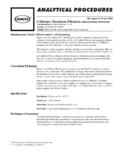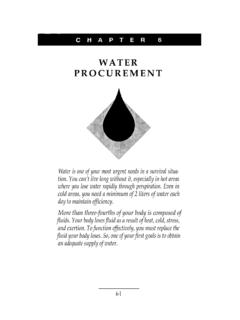Transcription of Preventing Travellers' Diarrhoea: How to Make Drinking ...
1 Sustainable Development and Healthy Environments water , Sanitation and Health WHO/SDE/ Distr.: General English onl Preventing Travellers' diarrhoea : how to Make Drinking water Safe Geneva 2005 World Health Organization 2005 This document may be freely reviewed, abstracted, reproduced and translated in part or in whole but not for sale or for use in conjunction with commercial purposes. Inquiries should be addressed to: The designations employed and the presentation of the material in this document do not imply the expression of any opinion whatsoever on the part of the World Health Organization concerning the legal status of any country, territory, city or area or of its authorities, or concerning the delimitation of its frontiers or boundaries.
2 The mention of specific companies or of certain manufacturers products does not imply that they are endorsed or recommended by the World Health Organization in preference to others of a similar nature that are not mentioned. Errors and omissions excepted, the names of proprietary products are distinguished by initial capital letters. The World Health Organization does not warrant that the information contained in this publication is complete and correct and shall not be liable for any damages incurred as a result of its use. WHO information products on water , sanitation, hygiene and health can be freely downloaded at: Preventing TRAVELLERS' diarrhoea : how to MAKE Drinking water SAFE Waterborne disease is common in all parts of the world where there is poor hygiene and sanitation.
3 traveller 's diarrhoea alone, whose principal causes are contaminated food and water , is estimated to affect 20-50% of travellers - or approximately 10 million people per year1. The most common source of exposure to disease-causing organisms for travellers is ingestion of contaminated Drinking water and food. An estimated 80% of TD cases are caused by bacterial pathogens2 ( , , Shigella, Salmonella, Vibrio cholerae). Other pathogens are viruses ( hepatitis A & E viruses, caliciviruses, rotaviruses) and protozoa (Giardia lamblia, Cryptosporidium parvum, Entamoeba histolytica, and Cyclospora).
4 Appearance can be deceiving. In some parts of the world, tap or bottled water may not be safe. The information below aims to assist travellers in making sure that the water they drink is safe. What to do before travelling? Check with your local disease prevention agency or your physician for recommended vaccines and medications for the countries which you plan to visit several weeks before you leave. Your physician could also recommend that you visit a specialized travel medicine clinic, if one exists nearby. For more detailed advice, please refer to WHO's International Travel and Health: This guide gives helpful tips on the full range of health risks likely to be encountered at specific destinations and associated with different types of travel from business, humanitarian and leisure travel to backpacking and adventure tours.
5 Take along a medical kit containing water disinfectant agents such as iodine tablets or solution, chlorinating-flocculating products, and/or chlorine bleach tablets. Most of these chemicals can be obtained from local pharmacies or at 1 CDC 2 CDC stores selling outdoor sports equipment. They are potentially hazardous if used incorrectly and should be used according to manufacturers' instructions. If you use a water treatment device, be sure that it has been tested and certified to remove protozoa (Giardia and Cryptosporidium) by a credible organization, and if a filter, that it has a filter media pore size of 1-micron or less.
6 Treating water of Questionable Quality Bringing water to a rolling boil is the most effective way to kill all disease-causing pathogens. Let the hot water cool down on its own without adding ice (as one cannot be sure if the ice itself is safe). If it is not possible to boil water , chemical disinfection of clear, non-turbid water is effective for killing bacteria and viruses and some protozoa (but not, for example, Cryptosporidium). Chlorine and iodine are the chemicals most commonly used for disinfection. A product that combines chlorine disinfection with coagulation-flocculation ( , chemical precipitation) should be used, when available, as these products remove significant numbers of protozoa, in addition to killing bacteria and viruses.
7 If turbid water ( , not clear, or with suspended solid matter) is to be disinfected with chemicals, it should be cleared beforehand by, for example, letting the impurities settle, or by filtering. Portable point-of-use (POU) devices tested and rated to remove protozoa and some bacteria are also available. Ceramic, membrane and carbon-block filters are the most common types. Selecting the most appropriate filter pore size is crucial; a size of 1 micron or less for the filter media pore is recommended to ensure removal of Cryptosporidium in clear water . Unless water is boiled, a combination of technologies ( , filtration followed by chemical disinfection or boiling) is recommended, since most POU filtration devices do not remove nor kill viruses.
8 Reverse osmosis (very fine pore filtration that holds back dissolved salts in the water ) and ultrafiltration (fine pore filtration that passes dissolved salts but holds back viruses and other microbes) devices can theoretically remove all pathogens. Often, after chemical treatment, a carbon filter is used to improve taste and, in the case of iodine treatment, to remove excess iodine. See Annex for a table of disinfection methods and their advantages and shortcomings. Silver, contrary to widespread perception, is not an effective disinfectant (biocide) and is thus not recommended for water disinfection.
9 Its presence in some filters is intended only to extend the life of the filter by retarding growth of non-disease causing bacteria that may plug filter pores. General preventive measures while travelling Drink bottled water provided in sealed, tamper-proof containers and bottled by known brands (which, preferably, have been certified by responsible authorities). Hotel personnel and/or host families are often good sources of information about which local brands are safe. Hot beverages such as coffee and tea are often made with boiled water and are therefore usually safe. Other beverages should be prepared with safe water (as per above).
10 Avoid consumption of homemade or non commercial, unpasteurized juices. Carbonated bottled beverages (sodas) and pasteurized or canned juice, sports beverages and pasteurized, boiled or sterilized milk (without ice) are normally free from microorganisms which could cause TD. Bottled beer, wine and other alcoholic beverages are also normally safe, although Drinking alcoholic beverages may in fact, especially in hot climates, contribute to dehydration unless other safe liquids are consumed. Do not eat salads or other uncooked dishes that may have been washed or prepared with unsafe water .


















